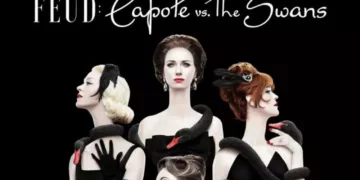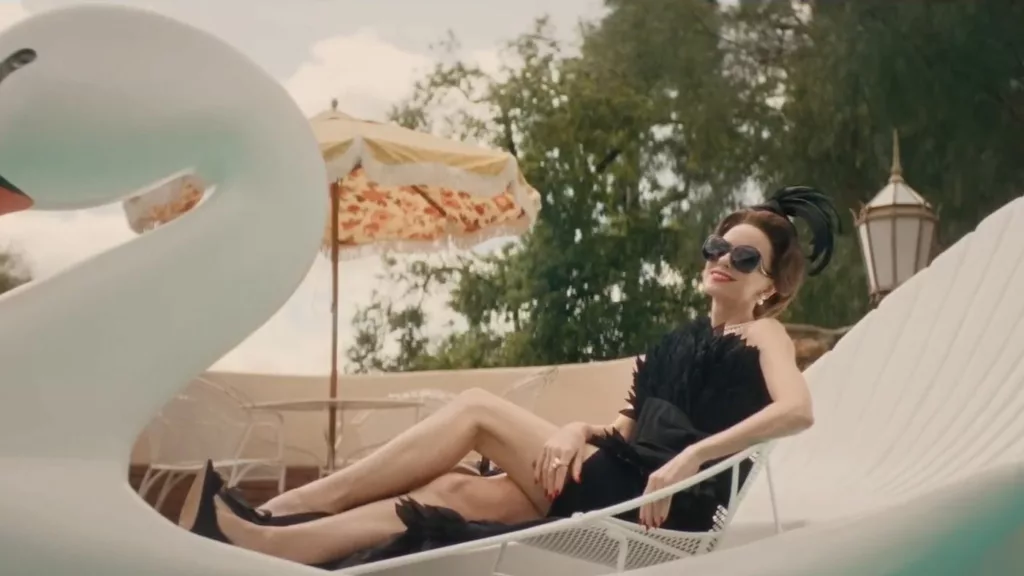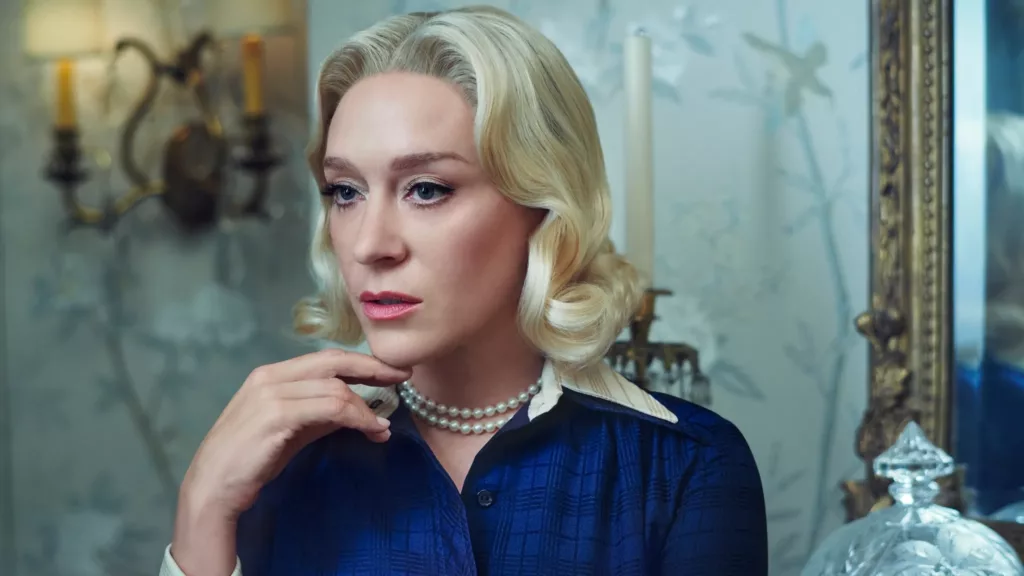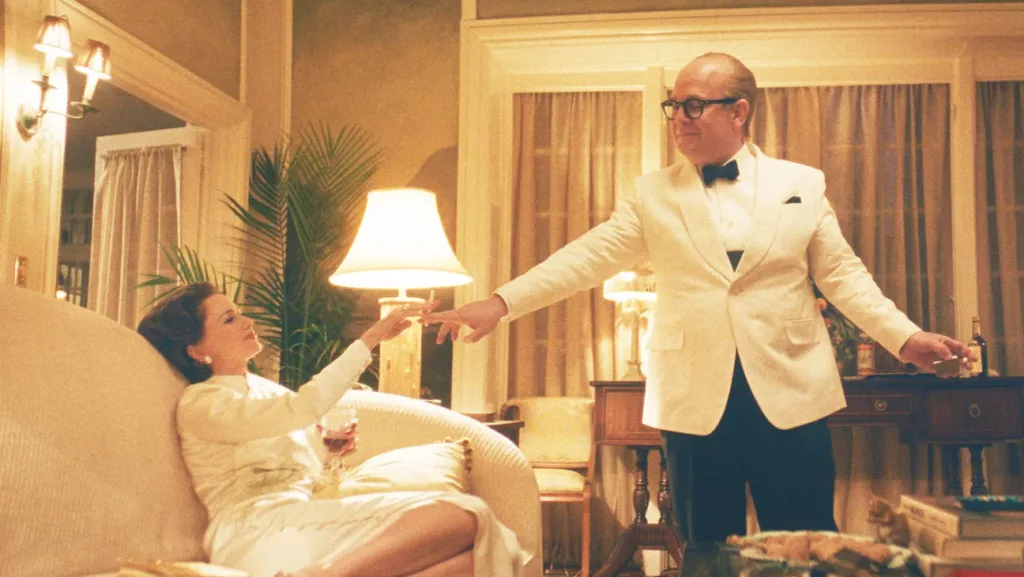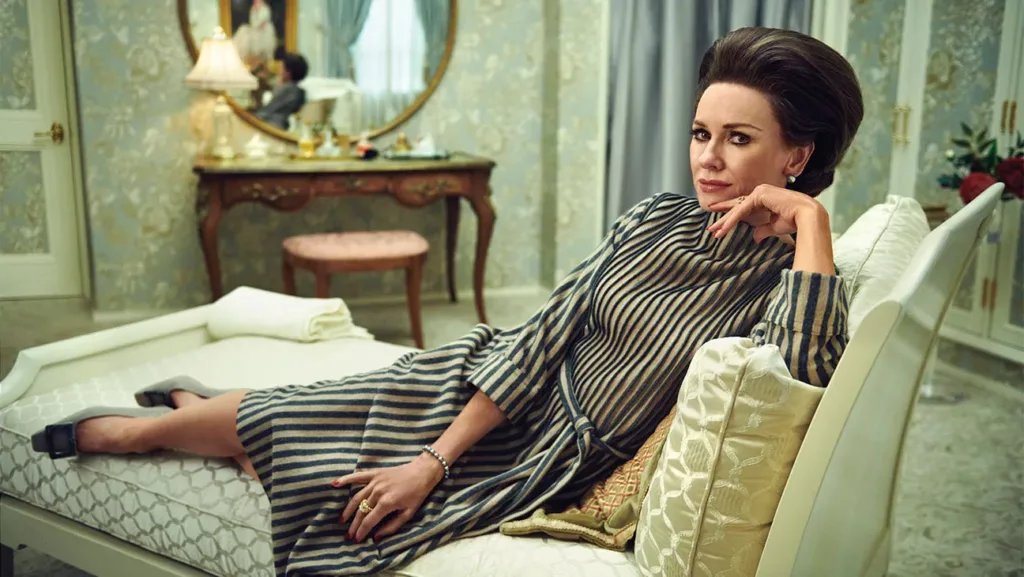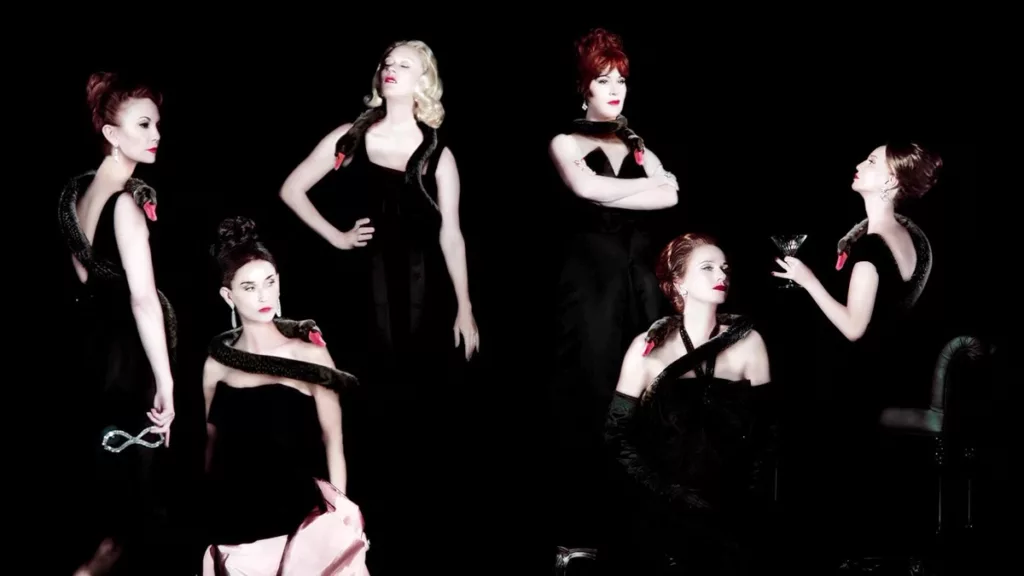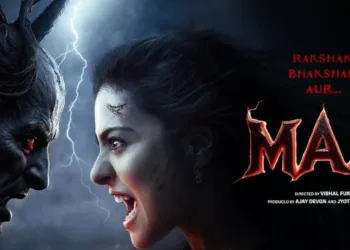Are you familiar with Ryan Murphy’s addictive anthology series Feud? After the deliciously dramatic 2017 matchup between battling Hollywood legends Bette Davis and Joan Crawford, Feud’s catty claws are back out for round two. This time, Murphy and crew sink their teeth into the backstabbing betrayal between iconic writer Truman Capote and his once-loyal flock of high society gal pals.
See, Capote had spent decades cozying up to New York City’s crème de la crème — or “swans” as he called them — to gossip over lunch and gain access to their glitzy world for his writing. We’re talking the like of CBS head honcho Bill Paley’s elegant wife Babe (played to perfection by Naomi Watts), Hollywood socialite Slim Keith (Diane Lane), and Lee Radziwill, Jackie O’s little sister (a devilish Calista Flockhart). But when an excerpt from Capote’s long-awaited novel Answered Prayers hits Esquire in 1975, baring the swans’ secrets and scandals for all to see, the claws come out in full force.
What follows in Capote vs. The Swans is a biting eight-episode look at the fallout between a circle of backstabbing frenemies, as this once tight-knit squad turns their cold shoulders on poor Truman. Led by a pitch-perfect Tom Hollander as the witty yet tortured writer, the drama dives deep into Capote’s alcoholism, self-destruction, and lingering questions around his unfinished (and suddenly very unflattering) blockbuster book. Juicy dinner scenes filled with incisive barbs give way to melancholic musings on fame, aging, and the bonds between society’s peak and its outcasts.
Gossip lovers and Murphy fanatics, consider this one the cinematic equivalent of a dishy lunch with your most unfiltered pals. Just beware… not even decades-long friendships emerge unscathed when pride and prestige are on the line.
Pitch-Perfect Ensemble Led by Hollander’s Haunting Turn
Any Ryan Murphy production comes with sky-high expectations of splendor, and Capote vs. The Swans delivers in spades courtesy of its exceptional ensemble. Leading the talent-stuffed charge is Tom Hollander, who simply disappears into the eccentric author’s inimitable wheeze and mannerisms. With his whispered squeak of a voice, Hollander nails Capote’s creep of a New Orleans drawl and fidgety physicality, making you forget a brilliant actor lurks underneath the flamboyant facade. Yet the genius lies in how he teases out the shredded humanity beneath all the affectations and zingers, exposing the gnawing loneliness and self-destructive urges poisoning Capote’s soul.
https://www.youtube.com/watch?v=YabKNs66eeg
As tortured writer’s tragic bestie Babe Paley, Naomi Watts radiates brittle glamor and haughty poise with fissures of hurt cracking just below the surface. She serves up vicious barbs behind a coy smile, flashing cunning eyes that mourn the loss of her dearest confidante. The two share a palpable chemistry steeped in decades of intimacy, making their estrangement cut all the deeper. Amongst Capote’s circle of socialite frenemies, Diane Lane gloriously chews scenery as catty queen bee Slim Keith, while Chloë Sevigny brings softer grace notes as gentle peacemaker C.Z. Guest. Molly Ringwald even stops by as a bubbly foil from La La Land.
Murphy darlings aren’t the only blasts from the past. Calista Flockhart hasn’t been this deliciously nasty since her Ally McBeal days as Jackie O’s embittered sister Lee. And ’90s icon Demi Moore savors every venomous put-down as the suspected murderer he tragically exposes. But it’s the late, great Treat Williams in his final performance who stuns as Babe’s bombastic yet broken husband Bill. The TV titan’s blustering pride and pain makes their shredded union sing.
With nostalgic star wattage to spare, Capote vs. The Swans boasts an embarrassment of riches. But make no mistake, this show belongs to Hollander’s haunting transformation. In a story steeped in betrayal and regret, his Capote epitomizes the cost of forsaking true intimacy for personal glory. Consider it a masterclass in acting and in the true meaning of friendship.
An Opulent Playground Brought to Life
Transporting viewers back to the indulgent 1960s heyday of New York high society, Capote vs. The Swans lavishes the screen with sublime period details. We’re talking posh penthouses bathed in jewel tones, spotlighting lacquered furniture and modern art lining the walls. Fancy French bistros where ladies who lunch don enormous hats and elbow-length gloves, sipping cocktails while trading gossip and glances. Towering, expertly coiffed bouffants that would make Amy Winehouse proud. And Truman’s own flamboyant rotation of colorful suits and printed scarves topping off his trademark oversized glasses.
It’s a playground for the senses steeped in wealth and sophistication — and production designer Michael Shaw nails every ounce of oppulence. Gus Van Sant largely stays out of the way too, embracing an understated approach that sets the stage for the characters to command center stage. But he still seizes the chance for a few stylistic flourishes along the way. A stunning black-and-white episode shot in faux documentary style offers an intimate peek behind-the-scenes of Capote’s legendary 1966 costumed ball. And an hour spent wandering 1970s New York City with James Baldwin drips with dreamy melancholy, the bustling metropolis reflecting the characters’ fading glory days.
While the visual splendor certainly dazzles, what makes Feud sing lies in the intimate bonds between friends…and the agony when those bonds break. Against this backdrop of glamor and betrayal, the substance of Capote vs. The Swans emerges timeless and poignant. In the end, personal pain and longing eclipse even the most fabulous parties and ensembles money can buy. And beneath all their fine social armor, each character craves that universal desire: to love and be loved for their truest self, free of judgment or pretense.
A Thoughtful Portrait Undermined By Messy Storytelling
Led by screenwriter Jon Robin Baitz, Capote vs. The Swans brings admirable emotional depth to the rock stars of New York’s social scene. Baitz clearly feels immense empathy for Capote and his swans, reflecting movingly on humanity’s universal struggle for purpose amidst finitude. His layered script teases out the anguish and intimacy tying Truman to his ladies who lunch. Were the swans his coveted muses inspiring great art? Devoted friends offering treasured understanding few others could? Or simply useful pawns for collecting attention-grabbing gossip, ripe for exposure once their usefulness ran dry? The heart of the show lies in contemplating such complex questions with thoughtful nuance.
Unfortunately the series too often falters capturing the evolving feud’s central narrative tension. Scenes seem to hop haphazardly across the mid-’70s timeline, making it difficult to trace how circumstances and motivations shift over the years-long fallout. Major plot points get introduced only to lie dormant for episodes as focus drifts to repetitive musical chairs of Capote reuniting with and relapsing on various swans. By the final episode it feels the show lost sight of fully excavating itsInvite central premise — the salacious intra-society betrayal — in favor of ragging philosophical meditations. Not that those meditations fall short. But Baitz seems so keen humanizing his lead characters, one wishes he more carefully considered how to keep viewers as invested in the feud’s emotional stakes.
Despite its periodic lack of momentum, Capote vs. The Swans sustains intrigue through thoughtful character development and thematic depth. But messy execution of the central feud results in a show whose parts unequal its emotional sum. With some structural tightening the series could have balanced virtuosic portraits of fame, trust, and human longing with sheer scintillating scandal. If only Baitz wielded his pen — as Capote did at his brief brightest — to more cunningly fuse high-mindedness with mass entertainment.
Walking the Murky Line Between Truth and Storytelling
As a “based on a true story” Ryan Murphy joint, Feud: Capote vs The Swans obviously takes some creative liberties in dramatizing real-life events. It’s not a beat-for-beat historical reenactment, but rather a vivid piece of storytelling sprung from a scandalous sliver of the past. Screenwriter Baitz used established biographies and insider accounts to craft his interpretation of Capote’s bust-up with New York society. But he also openly inserts imagined meetings, conversations, and closure that never actually occurred.
So where should viewers draw the line between factual truth and dramatic embellishment? In Capote’s own words: “Never let the truth get in the way of a good story.” As an author famous for blending fiction and reality with slippery ease, Capote likely would’ve condoned certain flights of fancy in service of emotional truth. But for sticklers on historical accuracy, liberties like inventing Capote’s “final words” before his death or forcing heart-to-hearts between real figures where none took place could rankle (the emphasis on his mother issues also draws raised eyebrows from some circles).
Ultimately the series wants viewers to connect with its bittersweet rumination on friendship, longing and regret more so than nitpick fact from fiction. But for those less forgiving of dramatized history, its blurred lines may pose a distraction. Personally, this reviewer found the show’s thoughtful exploration of eternal human themes to resonate in spite of – or perhaps because of – its gray area approach to “truth.” But each viewer must ask where they balance appreciation for artful storytelling and desire for journalistic integrity when real people and consequences are involved. If nothing else, Feud: Capote vs The Swans makes for a juicy conversation starter on that very relevant debate.
An Intimate Portrait of Human Frailty Behind Gilded Gates
While dissecting the central feud, Capote vs. The Swans explores poignant universal themes bubbling beneath the surface of its rarified playground. Age, addiction, and the hunger for belonging loom large for Capote and his swans beneath the glamorous facade. As Truman and his ladies who lunch enter their later years lacking fame or family to show for it, once-effervescent lives stagnate into sorrowful stupors of booze and pills to numb the pain. Mortality starts weighing heavy during Babe’s tragic battle with late-stage cancer, confrontation with aging spawning tearful late-night calls between comrades commiserating about vanishing youth and relevance.
The series also subtly unpacks societal barriers surrounding gender and sexuality through an eloquent lens. Socialites like Babe and Lee radiate an almost queer kinship with Capote, their dearest confidante and connection amidst unfulfilling, lonely marriages. Dialogue thoughtfully contemplates bonds pairing sharp-tongued “outsiders” with society’s feminine elite behind closed doors. “We see the importance of presentation, that’s how we defend ourselves,” muses Truman on shared struggles facing the gay community and coveted social class in 1960s America.
If the show has an Achilles heel, it lies in awkwardly shoehorning racial and socioeconomic concerns into theotherwise cloistered narrative. As New York’s most privileged and predominantly white literary icon, Capote probably wasn’t society’s strongest voice on systemic oppression. But Capote vs The Swans still makes some effort addressing the ignorance and isolation of Truman’s rarefied world. “There is a subtle racism below the surface of the water they swim in,” Truman notes of high society’s engrained privilege. “It’s never overt, but it’s subtle, and it’s meant to convey one thing: I am better than you.” An admirable observation even if somewhat disconnected from the show’s emotional core.
Uneven Yet Ultimately Affecting Rumination on Fame and Friendship
At just eight episodes, Feud: Capote vs. the Swans overstays its welcome by an hour or two. The series struggles maintaining narrative momentum, with a disjointed timeline and plot lines that meander and stall. But measured against the show’s thoughtful emotional insights and standout performances, such flaws feel forgivable. This remains intelligent, well-acted prestige television for viewers craving character depth over addictive drama.
Fans of high-brow celebrity gossip should sink their teeth into this latest Feud. Murphy devotees and anyone nostalgic for ‘90s icons like Watts and Moore will also find plenty to enjoy. Cinephiles will appreciate director Gus Van Sant’s understated aesthetics, accusing the opulent world with grace. And bookworms will relish the peek behind the curtain at Capote’s mysterious final novel.
Just don’t expect the salacious inertia of something like Netflix’s Inventing Anna; this fictional feud percolates at an ambling prestige pace. Hollander’s haunted lead turn captivates regardless, his Capote embodying the cost of forsaking true bonds for personal glory. For some the series may drag, feeling ten minutes of story stretched thin. But patient viewers will uncover affecting rumination on fame’s loneliness and friendships that transcend even grave betrayal.
Could showrunner Baitz have milked more juice from the central feud’s increasing melodrama? Certainly. Yet Capote vs. the Swans emerges most resonant in its tender humanity. When two hours feel more like four but you still walk away moved? Call it flawed but worthwhile. Like Capote and his swans themselves, imperfect vessels still capable of stirring great feeling. And isn’t that the essence of enduring art?
The Review
Feud: Capote vs. The Swans
Despite uneven pacing and some narrative flaws, Feud: Capote vs. The Swans emerges as an elegant rumination on the complex bonds between outsiders and insiders. Timeless themes around friendship, aging, and identity elevate the soapy melodrama. And Hollander's soulful turn as Capote haunts. For patient viewers, a flawed prestige gem still glitters.
PROS
- Hollander gives a tour de force performance as Capote
- Elegant direction from Gus Van Sant
- Strong performances from supporting cast like Watts and Lane
- Lavish production design and costumes capture the era
- Explores poignant universal themes around friendship and identity
CONS
- Uneven pacing and narrative momentum
- Timeline is disjointed and confusing
- Underdeveloped exploration of the central feud
- Can feel repetitive in parts
